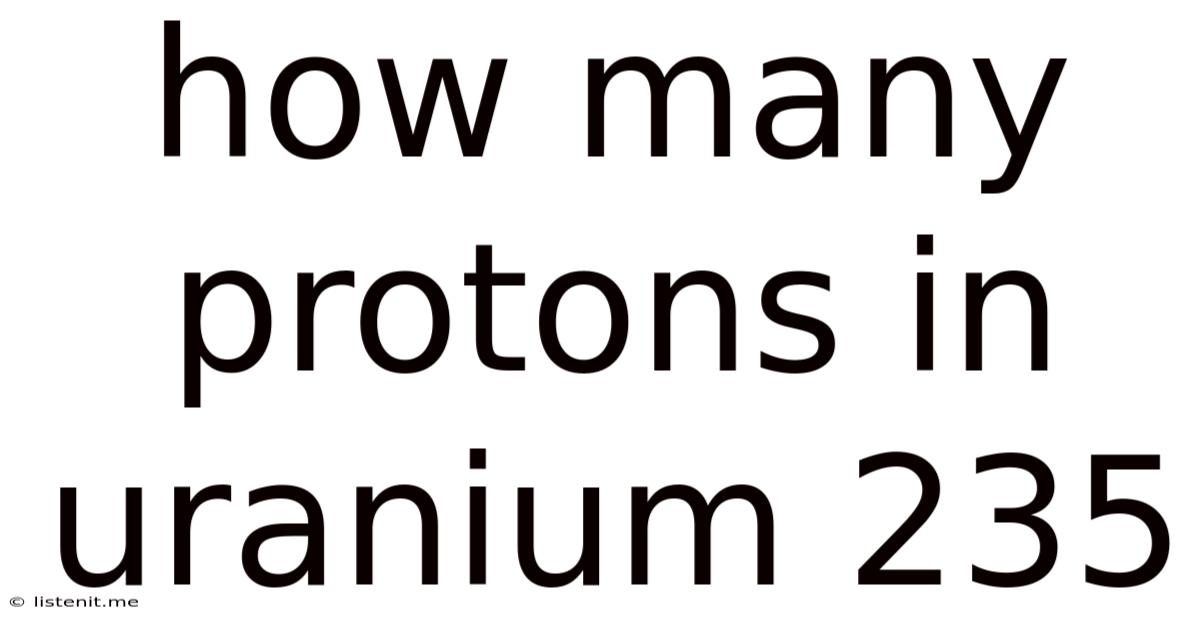How Many Protons In Uranium 235
listenit
May 11, 2025 · 4 min read

Table of Contents
How Many Protons in Uranium-235? Understanding Atomic Structure and Isotopes
The question, "How many protons in uranium-235?" is a fundamental one in understanding atomic structure and the nature of isotopes. The answer itself is simple, but the context surrounding it reveals a wealth of information about chemistry, physics, and nuclear energy. Let's delve into the details.
Understanding Atomic Structure: Protons, Neutrons, and Electrons
Before we answer the question directly, it's crucial to grasp the basic building blocks of an atom. Every atom consists of three fundamental particles:
- Protons: Positively charged particles located in the atom's nucleus. The number of protons determines the element's identity; it's the defining characteristic that distinguishes uranium from other elements.
- Neutrons: Neutral particles (no charge) also residing in the nucleus. Neutrons contribute to an atom's mass but not its charge.
- Electrons: Negatively charged particles orbiting the nucleus in electron shells or energy levels. The number of electrons typically equals the number of protons in a neutral atom.
The arrangement of these particles determines an atom's chemical properties and behavior. The number of protons is critical because it dictates how the atom will interact with other atoms, forming molecules and compounds.
What is Uranium?
Uranium (U) is a naturally occurring radioactive chemical element with the atomic number 92. This means that every uranium atom contains 92 protons. This fundamental characteristic distinguishes uranium from all other elements on the periodic table. The number 92 is unchanging; it's the very essence of what makes something uranium.
Isotopes: Variations in Neutron Count
Now, let's tackle the "235" in uranium-235. This number refers to the mass number, representing the total number of protons and neutrons in the nucleus. Since all uranium atoms have 92 protons, the difference between various uranium isotopes lies solely in their neutron count.
Uranium-235 (²³⁵U) has a mass number of 235. To find the number of neutrons, we subtract the number of protons from the mass number:
235 (mass number) - 92 (protons) = 143 neutrons
Therefore, a uranium-235 atom contains 92 protons and 143 neutrons.
Other Uranium Isotopes: A Closer Look
Uranium exists in nature as a mixture of several isotopes, the most prevalent being uranium-238 (²³⁸U) and uranium-235 (²³⁵U). Both have 92 protons, but they differ in their neutron count:
- Uranium-238 (²³⁸U): 92 protons + 146 neutrons
- Uranium-235 (²³⁵U): 92 protons + 143 neutrons
The difference in neutron number significantly impacts the isotopes' properties, particularly their nuclear stability and radioactivity. Uranium-235 is fissile, meaning it can sustain a chain reaction of nuclear fission, which is the basis for nuclear power generation and nuclear weapons. Uranium-238, while also radioactive, is not fissile in the same way.
The Significance of Uranium-235's Properties
The fissile nature of uranium-235 stems from its specific nuclear structure. The arrangement of protons and neutrons in its nucleus makes it susceptible to neutron bombardment, leading to nuclear fission—the splitting of the atom's nucleus into smaller nuclei, releasing a tremendous amount of energy in the process. This energy release is what makes uranium-235 so valuable for both energy production and weaponry.
Nuclear Fission and Energy Production
Nuclear power plants utilize the controlled fission of uranium-235 to generate electricity. The heat produced from fission is used to boil water, creating steam that drives turbines and generates electricity. This process is highly efficient and generates a significant amount of energy from a relatively small amount of fuel.
Nuclear Weapons
The uncontrolled chain reaction of uranium-235 fission is the destructive force behind nuclear weapons. The rapid release of energy in an uncontrolled fission reaction results in a massive explosion, releasing devastating amounts of energy and radioactive materials.
Enrichment: Increasing the Concentration of Uranium-235
Naturally occurring uranium contains only a small percentage of uranium-235 (about 0.7%). To achieve the critical mass needed for nuclear fission in power plants or weapons, the concentration of uranium-235 must be significantly increased through a process called enrichment. Enrichment separates uranium-235 from uranium-238, concentrating the fissile isotope to a higher percentage, typically 3-5% for nuclear reactors and much higher for weapons.
Safety and Security Concerns
Due to its potential for both energy production and destructive applications, uranium-235 is a highly regulated material with strict safeguards and security measures in place to prevent its misuse. The handling, storage, and transportation of uranium-235 require specialized facilities and expertise to ensure safety and prevent accidents or acts of terrorism.
Conclusion: The Importance of Knowing the Number of Protons
The simple answer – 92 protons – is foundational to understanding uranium-235's properties and significance. Knowing the number of protons not only defines the element but also allows us to understand its isotopic variations, its fissile nature, its use in nuclear energy, and the crucial safety considerations surrounding its handling. The seemingly simple question opens a door to a complex and fascinating world of nuclear physics and its implications for society. From power generation to the ethical concerns surrounding nuclear weapons, the understanding of uranium-235 and its 92 protons remains a vital part of scientific literacy and global affairs.
Latest Posts
Latest Posts
-
Is Square Root Of 7 A Real Number
May 12, 2025
-
How Is Electronegativity Related To Covalent Bonding
May 12, 2025
-
How To Find The Sum Of A Convergent Series
May 12, 2025
-
How To Solve 2x 3y 12
May 12, 2025
-
A Substance Made Of Only One Type Of Atom
May 12, 2025
Related Post
Thank you for visiting our website which covers about How Many Protons In Uranium 235 . We hope the information provided has been useful to you. Feel free to contact us if you have any questions or need further assistance. See you next time and don't miss to bookmark.